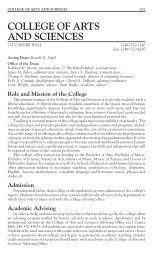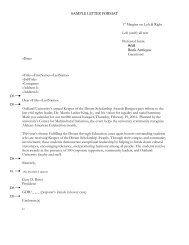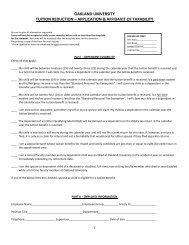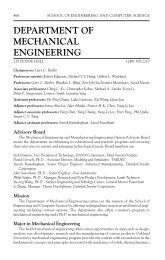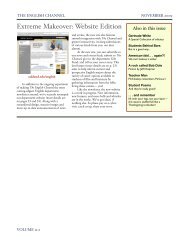MOM 2006 journal for pdf.pmd - University of Michigan-Flint
MOM 2006 journal for pdf.pmd - University of Michigan-Flint
MOM 2006 journal for pdf.pmd - University of Michigan-Flint
Create successful ePaper yourself
Turn your PDF publications into a flip-book with our unique Google optimized e-Paper software.
A TIME FOR ‘TRANS’ITION: AN ECONOMIC PERSPECTIVE FOR A<br />
PUBLIC HEALTH REMEDY<br />
Kyle Fluegge<br />
Faculty Sponsor: Paula Nas<br />
Department <strong>of</strong> Economics, <strong>University</strong> <strong>of</strong> <strong>Michigan</strong>-<strong>Flint</strong><br />
Upon inspection <strong>of</strong> the ingredient list on many American food products, one can find the<br />
words “partially hydrogenated vegetable oil” as a principal ingredient. Most <strong>of</strong> us are oblivious as<br />
to the quantities <strong>of</strong> these oils in our everyday food products. This is due in large part to the fact<br />
that they are so routinely used to make over 40,000 products in the average grocery chain in the<br />
United States, amounting to approximately 40% <strong>of</strong> the nation’s food supply (Severson 1B).<br />
Some <strong>of</strong> the products containing these oils include the following: margarines, butter, all fast food<br />
fries, chicken and other deep-fried foods, pancakes, baked goods like cookies, cakes, pie crusts<br />
and shortening-based frostings, breads, and doughnuts. With such high prevalence rates <strong>of</strong><br />
partially hydrogenated oils (PHOs), it is not surprising that most Americans are not avoiding<br />
these additives.<br />
The birth <strong>of</strong> PHOs came with its patent by William Norman in 1903. Norman discovered a<br />
hydrogenation process through which he infused healthy liquid vegetable oils with hydrogen<br />
atoms to make the resulting fat solid at room temperature, called a trans fat. These extremely<br />
inexpensive oils were a blockbuster <strong>of</strong> the time because they protected against rancidity by<br />
extending the shelf life and improving the taste and texture <strong>of</strong> the foods containing them<br />
(Dewey).<br />
The U.S. Food and Drug Administration currently approximates that Americans typically get<br />
from between three to thirteen grams day <strong>of</strong> trans fatty acids in their diets daily (McClellan and<br />
Thompson 41444). Dr. Mary Enig, a consultant, clinician, and the Director <strong>of</strong> the Nutritional<br />
Sciences Division <strong>of</strong> Enig Associates, Inc., Silver Spring, Maryland, has researched that this<br />
estimate could be very low. In her interview with Dr. Richard Passwater, Dr. Enig noted that<br />
foods including French fried potatoes, cookies, crackers, and doughnuts have averaged about a<br />
45% trans fat composition. In addition, someone who eats a lot <strong>of</strong> these foods could consume<br />
sixty grams <strong>of</strong> trans fats in one day.<br />
Although this number might seem staggering, the effect <strong>of</strong> these trans fats is most important in<br />
analyzing their dangerous characteristics. The Harvard School <strong>of</strong> Public Health prefaces these<br />
effects <strong>of</strong> trans fats by first explaining the body’s use <strong>of</strong> low-density lipoproteins (LDL) and highdensity<br />
lipoproteins (HDL).<br />
Meeting <strong>of</strong> Minds <strong>2006</strong> 22




